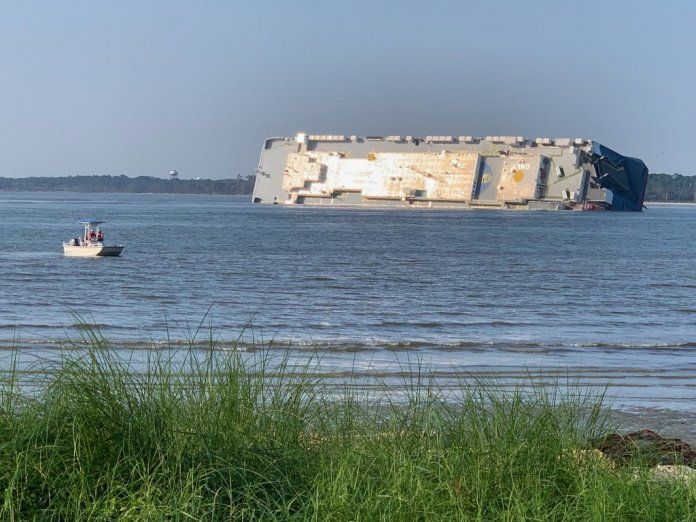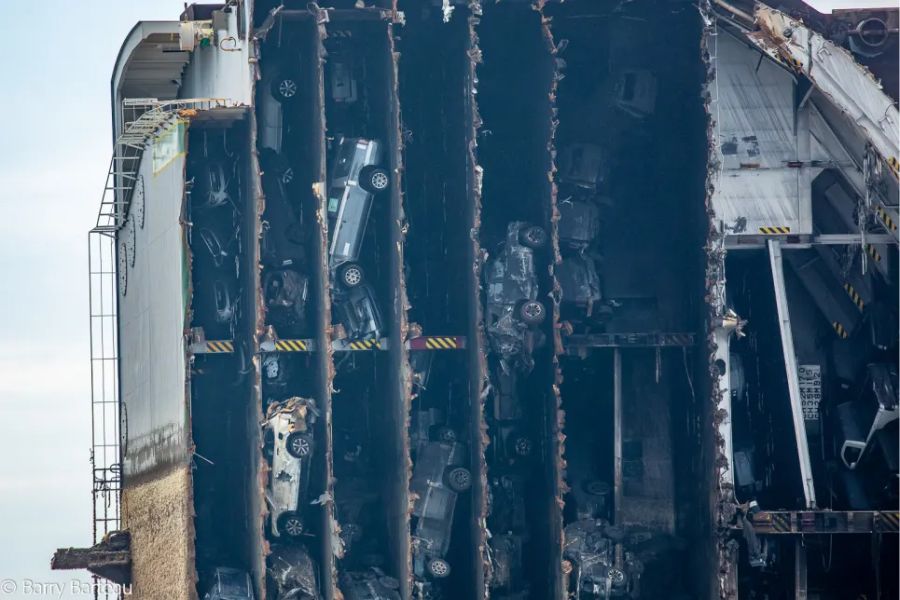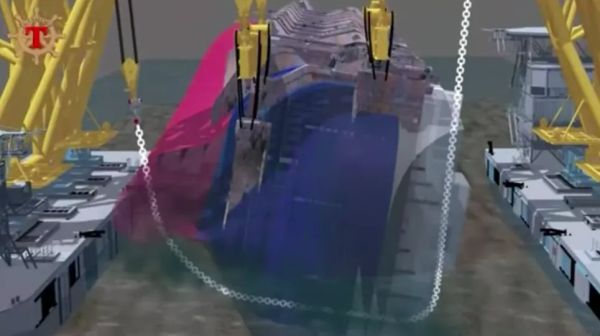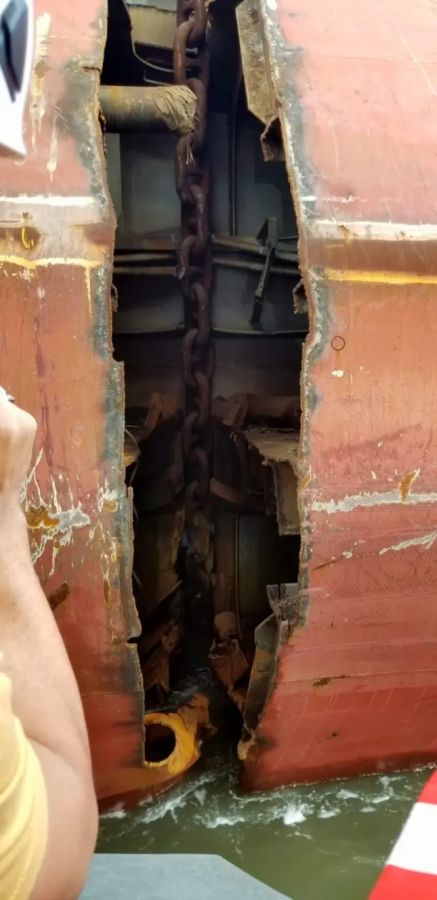This makes me happy. I wish someone would record the sound, which must be amazing. I bet you can hear it a long way off; it’d make a great sound-track for Mordor.
[I’m sorry, by the way, if this blog is a bit light and fluffy lately. I’m trying to keep my mind on the good things, not the horrible situation that we are all in. Except I’m aware that the horrible situation will probably never get better, ever, again.]
Jalopnik describes a fascinating system that is being used to disassemble a capsized boat full of cars. [jalopnik]
So, if you have a ship-load of cars and they’re not loaded with correct balance, the ship can tip and then it never un-tips. How does one correct that? You can’t go inside it and re-balance the contents; the ship is junk and needs to be scrapped. This is known as “one hell of an expensive mistake.”

[source]

Wait, what? That’s a cross-section of a car-carrier ship! Cars included.
I would have expected they’d take the ship apart slowly and painfully with oxy/acetylene torches and hazmat controls (I assume the cars have gasoline in each of their tanks…) at tremendous expense. Not that this is cheap in either case, but it’s a brilliant hack.

So, you build some gigantic floating crane-things on barges, which can support a large chain (shown above) looped under the ship – then the chain saws back and forth like Sauron’s own cheese-wire and slices the ship into manageable chunks. Those are 80-lb links each of which is 3 feet long.
Incidentally, old wrought iron ship anchor chains are prized by knife-makers particularly, because they’re perfectly sized for making hammers and whatnot. This chain would not be wrought iron, but … wow. Also related, there is various footage on youtube of how anchor chain, which is still a necessary commodity, is made and that’s pretty intense, too. You just take some, you know, 12-foot long bars of 3″ diameter steel at welding temperature and use a hydraulic actuator to bend the bars around a pair of mandrels and weld them at the contact-point. Then you weld in the center-piece which, since it’s not load-bearing, is usually plain old cast iron. Those chain links are too intense for a typical blacksmith, but I know folks who’ll sell you half of a link of victorian anchor-chain for $150 and it is some of the yummiest wrought iron you’ve ever seen — too bad it costs $130 to ship it.


You can make your own grindy mouth-noises as you imagine what that chain sounds like as it slides back and forth. I assume various parts of the ship resonate at different frequencies, though mostly the chain is doing its work under water (where it is lubricated and cooled by the water; very clever).
The sound my brain fills in is kind of like “GRONK GRONK GRONK GRONK” except it goes on a long time.

Wow, that’s incredible. I imagine it has a few different sounds. Maybe a sonorous shifting hum when underwater and a grinding see-saw above the water line that thunks when it hits more resistance.
I appreciate the light tone right now. Our world may not be doing well, but a positive attitude makes my days easier. The best way to conquer darkness is with light.
Okay … that’s one way.
Not to get too snarky I think they overlooked the obvious: It’s Georgia. Drag the hulk onto dry land and spread rumors that there is a safe full of gold, oxy, crack cocaine, and light beer inside. Set up cameras to record the ensuing comedy gold as the locals set to work with axes, crowbars, logging chains and discount store hand winches. Pay-per-view would easily cover liability, body removal and extra environmental cleanup caused by the widespread lack of toilet training and crack smoking around spilled gasoline.
In the real world it is indeed interesting. Chain … I guess as long as it is a relatively thin section of mild steel it makes sense. Less so around the engine block and mounts, and propeller shaft/s.
I would think a thin wire with abrasive properties moving fairly fast would have less tendency to bind and use up less energy cutting such a wide kerf. Some stone is cut with what amounts to a cable with diamond coated or carbide inserts. Before that technology was available they used an iron wire with diamond dust and oil. All while held taut and sliding along at high speed. There were horror stories of people walking into the wire.
That’s the full size version. This is the pocket version:
https://nordicpocketsaw.com/en/produkt/nordic-pocket-saw-premium/
Intransitive
First thing I thought of, too.
Your link seems borked, but I have one of these
https://www.coghlans.com/sportsman-s-saw-704
That’s making use of a phenomenon that large-scale tow truck operators try hard to avoid!
My husband has been watching TV shows following such heavy-hauler tow truck operators. Last night featured a semi truck that wrecked in a ditch. How do you pick up a semi trailer that is lying on its side in the snow, with the wheels higher than the roof, full of 15 tons of canned tomato sauce? Preferably without spending several hours unloading it; the highway authorities want to reopen the road NOW!
Somebody usually makes the remark on camera that if they just wrap a chain or strap around it and lift, the whole thing is going to come apart. Semi trailer walls are not intended to be load-bearing, and are actually pretty flimsy. If the chain doesn’t cut through the trailer walls, the wall will buckle under the weight and the load (that they’re trying to keep intact) will spill all over the highway. Often, the operators will place a length of wood or angle iron to distribute the weight enough to avoid buckling the corners and cutting though the walls.
In last night’s episode, they used heavy-duty airbags to support the wall, lifting the whole truck with an impressive air compressor, until it was high enough that straps rigged around the trailer could lift it the rest of the way onto its wheels safely. Impressive to watch, difficult and dangerous to do.
Ships’ hulls are a far sturdier problem. Using a massive chain as a large-scale wire saw is a very good idea!
You’d need a huge sound system to reproduce the sounds properly. What an amazing project.
Amazing. Also, holy crap, what a disaster, and I’m glad no one was killed.
I wonder if they have to also have barriers (in addition to the ones that are supposed to keep the environment “safe” although nothing seems to keep it safe from humans) to keep out everyone wanting to get a closer look at how they’re carving this thing up. I feel that I’m probably about the right distance from it right now, but a lot of people would want to get in on the action.
I just like imagining the chain of phone calls that would be involved after an accident like that. There’s the one to the ship owner, the shipper of the cars, the insurance company…
What tone of voice do you use when reporting that your ship just toppled over? Apologetic? Matter-of fact businesslike? Super embarassed? It’s hard to imagine.
Of course, what it would sound like to you depends on whether you are above or below water.[1]
Not much sound crosses from water into air.[2] A lot is reflected off the surface and back down.[3] But much of the ship is above water and vibrating too, of course. You’d definitely want good ear protection. I’m guessing lots of low/mid groans, along with some high squeals from grinding/tearing parts and so forth. I’m sure the machinery they’re using would be big and loud too.
Like the water, your head is much denser than air,[4] so if you’re underwater, it will carry some vibrations pretty well (and likewise can transmit plenty back into the water on its way out). However, your ears themselves don’t work as well,[5] so they don’t directly pick up as much as they would in air.
The combined effect is roughly like you put it through a high-pass filter, along with some weird frequency-dependent peaks in the low-to-mid range which have subtle effects on the timbre. There can be some phasing too, so plop on a filter using an LFO to modulate the amplitude more or less randomly. And you need a heavy dose of reverb which makes everything sound … uh … as if you’re in a large stadium, with added wetness? Something like that.
It all sounds like a big headache to try to synthesize realistically, so maybe just record the damned thing under some actual water to save yourself the trouble. Then you’d only have to make a few relatively simple corrections to get what your ears (and not microphones) would hear in that situation. But maybe “GRONK GRONK” isn’t too far off.
[1] And the pressure, temperature, how rough the ocean waves are assuming you’re near the surface, etc.
[2] On the water, no one can hear the fish scream. But in the deep, dark depths of the ocean … fish don’t make very much noise, presumably. So it’s probably okay. Don’t panic.
[3] Or as wikipedia mentions, it can be scattered by fish, bubbles, and whatnot near the surface.
[4] No offense intended, regarding the density of your head. Just stating plain old facts here.
[5] I think simply because the hairs are harder to move in a denser medium. And humans evolved on land. Yet another defeat for the aquatic ape hypothesis.
What strikes me is that the hull is a lot thinner than you might expect, which may have something to do with this being quite so effective. Are they planning to make multiple cuts? I wouldn’t have thought half a capsized ship was all that much more wieldy than a whole one. Ok, after reading the article, seven cuts, for eight sections. I’m pretty impressed by the giant floating crane which can handle 1/8th of a car carrier in the first place. I suppose it’s a good example of the simple fact that in order to build / repair / scrap something really big you first need to build something slightly bigger.
That is one impressive chainsaw
anyway, some of those cars still look good to me*
(*i could rip the guts out and put them in an interesting chassis)
Marcus, I find it amazing that we build things that are so huge that, if they topple, can’t be recovered and need to be scrapped. Why, that ship is almost like a large software project.
The monstrous size of everything involved is awesome.
consciousness razor @ #9: I think simply because the hairs are harder to move in a denser medium.
The hairs are in your inner ear, inside the cochlea, permanently submerged in liquid. You actually hear reasonably well underwater if you allow your ear canal to fill with water so that it contacts the eardrum directly, but yes, the system is not optimal. In fact, the entire apparatus in your middle ear is designed to transfer the sound efficiently from air to the liquid in the cochlea. The tiny bones couple the relatively large eardrum to the much smaller oval window of the cochlea, in effect forming a mechanical impedance transformer (of which a lever is the simplest example). Underwater, you would probably hear better if you did not have the eardrum and the entire middle ear at all, and the water contacted the oval window of the cochlea directly.
It would be interesting to know what the ears look like in various other animals, how the arrangement used by mammals evolved, and how it changed in aquatic mammals.
lorn@#2:
From things you have said here in the past I expect you know about wire EDM – which would be insanely cool if scaled to the size necessary to slice ships.
brucegee1962@#8:
What tone of voice do you use when reporting that your ship just toppled over? Apologetic? Matter-of fact businesslike? Super embarassed? It’s hard to imagine.
(Beep) The Verizon cellular number you have reached: 814-553-2430 has been disconnected. The new number is +55 1146733499.
I just brain-farted on the title of my own posting and thought that “Heavy Metal” might fit well in the form of the intro (“Takin’ a Ride”) track by Don Felder from the 70’s movie by that name. Some of the guitar squeals and growls would probably fit right nicely with the sound of the chains, assuming you had another container ship handy, stacked with Marshall amps.
I’d pay to hear that.
… but nowhere near what the insurance company that underwrote that ship is paying.
Kinda similar to how they chopped the seafloor-embedded nose off the Kursk to recover the rest.
Huh. this is pretty interesting. Both in that a ship can be so unbalanced as to capsize, in this day and age of everything being computerized and planned to the point of ridiculousness, and also that they use a giant chain to chop it up.
I was initially puzzled at the choice of chain, and no abrasives/etc., but looking at the pics, I don’t think the major action is cutting/abrasion, but more bending/tearing. I think the “gaps” created by the alternating chain pieces are serving to ensnare bits of hull, I beams, stray cars, whatever, which then get torn/sheared/punched by the immediately following 3″ diameter chunk of steel.
While I’ll grant you we are still looking down the barrel of climate change, Trump is going to be gone soon and approved vaccinations against Covid start (here in the UK at least) next week. Stuff has got considerably better since even a couple of months ago, hasn’t it?
I am surprised it is just a normal looking chain. There are no sharpened surfaces as on a normal chainsaw.
I guess they forgot to set the parking brake on all those vehicles.
Yeah, I was figuring the problem was more literally with the eardrums themselves moving (and by extension the hairs), but I take your point that those already are in a liquid. It’s a very complicated system with a lot of effects going on at the same time, so I guess a bunch of things might explain it.
At any rate, we can of course hear something fairly well, but the qualities of the perceived sounds are quite different in such an environment. Trying to make sense of what seems like a blurry, distorted, unfamiliar mess is also a big factor, when we’re talking not just about whether something is merely audible but whether it’s heard clearly, meaning it’s interpreted accurately as something comprehensible so we can reliably use that information in various ways.
Perhaps, but I wonder if we’d pick up more ambient noises that could be pretty distracting. Not sure if the eardrum is a very useful filter in that respect, but thinking about all of the times I’ve had water loudly sloshing around in my head (it really does sound like my entire head has been flooded) makes me suspect that may do more harm than good.
I know very little about the biology, but I would not be surprised if fish and so forth do things very differently from us.
Cladistically, we are fish.
EDM I can see that working if it takes the form of flexible cables that instantaneously slice through metal at a touch:
https://www.youtube.com/watch?v=-H2doGWOHI8
Another form might be a really big light sabre. I’m not clear on how any of that might work, perhaps I missed that day in physics. But sure, in the fullness of time …
Yeah, if you want to see things done differently (and sometimes better – fovea I’m looking at you (but not seeing all of you clearly, obvs)) look at octopuses…